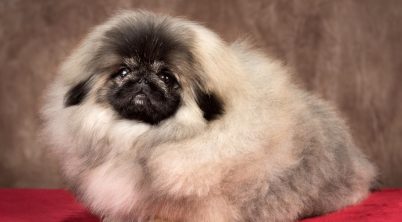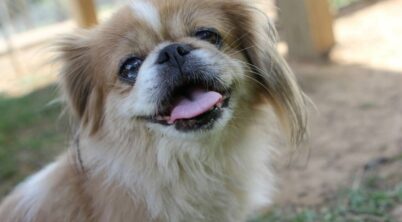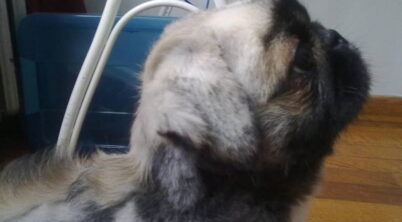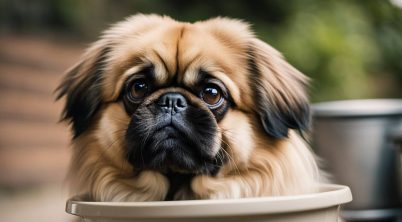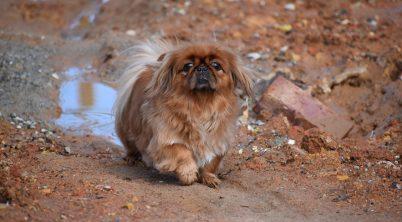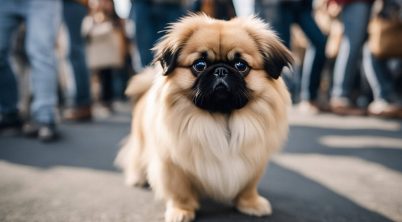The Pekingese is a toy breed of dog that hails from ancient China, indicating a heritage rich with cultural significance. This breed, known for its distinctive appearance resembling a lion, which earns it the nickname “lion dog,” was created for nobility and has a venerable status. Far from being bred as a hunting dog, the Pekingese was cherished by Chinese emperors and members of the imperial court for its companionship and was often found within the opulent confines of the Forbidden City in Beijing.
This breed’s history in China traces back over a millennium, with connections to Chinese emperors dating back to at least the 700s. Legends tell of the Pekingese’s magical origins, mixing the lion’s bold spirit with the grace of a marmoset, resulting in the Pekingese’s proud and loyal character. The breed’s physical features are characterized by a broad, flat face, a compact body, and a profuse mane of fur encircling the neck and shoulders.
While they are not utilized in hunting, the Pekingese possesses a strong-willed and independent nature, reflective of their imperial lineage. Their role has always been as a companion, receiving admiration for their dignified demeanor. Their long and luxurious coat comes in various colors and requires regular grooming to maintain their regal appearance. Despite their small size, the Pekingese carries itself with the confidence and self-importance of a much larger animal.
Table of Contents
Pekingese Hunting Dog
The Pekingese is a toy breed that was historically cherished by Chinese royalty. Their stature and physical characteristics do not align with traditional hunting dog roles. They possess a regal bearing and a distinctive rolling gait, and while they hold the nickname “lion dog,” this is more reflective of their appearance than a hunting prowess.
- Size: Small (toy breed)
- Coat: Thick fur, especially around the neck
- Temperament: Independent and companionable
Hunting Aptitude
- Strengths: Pekingese are alert and could potentially assist in alerting hunters to nearby game due to their acute senses.
- Limitations: Their short legs are more suited for leisurely strolls rather than the rigorous demands of hunting.
Pekingese as Hunting Companions
While Pekingese dogs are not typically utilized as hunting dogs due to their size and physical capabilities, they can enjoy activities that stimulate their instincts. Engaging with Pekingese in simple tracking games or teaching them to find specific scents within the home can provide mental and physical enrichment. These activities can play to the Pekingese’s strengths, such as their keen sense of smell and inquisitive nature.
It should be noted that Pekingese are primarily companion animals. They thrive in environments where they can be close to their owners rather than in roles that require high physical exertion like those demanded of hunting dogs.
Origins and History
The Pekingese breed, with its regal demeanor and distinct appearance, has a storied past intertwined with Chinese royalty. They are believed to have originated in the imperial courts of China. Their history is ancient, dating as far back as the Tang Dynasty, around the 8th century. The breed symbolized the historic grandeur of the imperial family and was not originally bred for hunting, but rather as a companion animal for the members of the royal court.
Key Historical Highlights:
- Imperial Guardians: Often found in the laps of emperors, the Pekingese served as a living symbol of the Chinese lion, believed to ward off evil spirits.
- Buddha’s Mythical Influence: Legend suggests the breed was created by Buddha, who transformed a lion into this smaller canine companion.
- Exclusivity among Nobility: Ownership of the Pekingese was originally restricted to the Chinese nobility. Commoners had to bow to them, and only those of royal bloodline could own one.
- British Intervention: During the Second Opium War in the 19th century, British forces invaded the Summer Palace in Beijing and discovered the Pekingese, which were then transported back to England.
- Looty: The first known Pekingese brought to Britain was taken from the Summer Palace and given to Queen Victoria, who named it Looty.
Breed Dissemination:
Following their arrival in England, the British soon took a keen interest in the Pekingese, with the breed quickly finding favor among the British royalty and aristocracy. Queen Victoria’s acceptance of Looty likely spurred the breed’s popularity, earning them a special place within British high society.
This snapshot of history reflects the transition of the Pekingese from an emblem of Chinese emperors to a cherished pet in the West, retaining their status as symbols of distinction and elegance.
Physical Characteristics
The Pekingese, often referred to as “lion dogs” due to their mane-like coat, boasts a distinctive physical appearance that is both regal and unique. They exhibit a well-proportioned face with a short, flat snout and large, expressive eyes that are characteristic of the breed. Their ears are heart-shaped, lying close to the skull, adding to their notably confident expression.
Coat and Color: This toy breed possesses a luxurious double-coat that consists of a thick, soft undercoat and a longer outer coat. The coat comes in a variety of colors including black, white, red, sable, fawn, cream, tan, gold, and even blue and gray. Unique to the breed, some Pekingese have a black mask that accentuates their facial features.
Size and Structure: The Pekingese is compact and stocky, with a notably muscular build. In terms of size, they stand 6-8 inches tall at the shoulder and weigh up to 14 pounds. They have a characteristic rolling gait that complements their stately bearing.
Fur Density and Texture: The dog’s outer coat is long and coarse, providing a dignified ‘lion’s mane’ around the neck and shoulders. The Pekingese’s coat requires regular grooming to maintain its appearance and health.
- Height: 6-8 inches
- Weight: Up to 14 pounds
- Body Type: Stocky and muscular
The Pekingese’s physical characteristics are a testament to its royal lineage and the centuries of selective breeding that have emphasized these traits. Their stature, although small, conveys a strong, imperious presence, befitting their history as dogs of Chinese nobility.
Temperament and Behavior
The Pekingese showcases a spectrum of temperaments ranging from independent to affectionate, with an intrinsic regal demeanor. They possess a strong personality and often display aloofness towards strangers, resonating with their ancient status as dogs of Chinese nobility. Despite their small size, their behavior is fearless and alert, making them excellent little watchdogs.
In terms of family affection, the Pekingese can develop deep bonds and display affectionate behavior towards familiar faces. They are generally not as friendly with strangers or unfamiliar children, preferring the company of adults or older kids who respect their boundaries. They may not be the ideal pet for households with very young children, due to a possible mismatch in energy levels and the need for gentle handling.
When it comes to other pets, socialization is key. With a tendency to be stubborn at times, early and consistent training will help the Pekingese to better adapt and coexist with other household animals. Their independent nature might require a firm, yet gentle training approach. Their intelligence shines through in their behavior, as they are quick to learn, albeit on their own terms.
While not the most energetic breed, the Pekingese require regular exercise to keep up their energy level and maintain good behavior. Short daily walks and play sessions help to channel their energy positively. It’s imperative to understand and appreciate their unique blend of temperament characteristics to foster a harmonious living environment.
Training and Activities
When training a Pekingese, it’s essential to understand their moderate energy levels and unique gait, which play a significant role in the types of activities they can handle. These dogs, while not traditional hunting dogs, exhibit courageous behavior and are effective watchdogs.
Training Techniques
The Pekingese can be independent, yet they respond well to training that incorporates positive reinforcement. They are more trainable when motivation is present in the form of praise or treats. Given their stature, care should be taken during training not to encourage activities that might strain their rolling gait. Training should focus on:
- Basic obedience commands such as sit, stay, and come
- Watchdog training to hone their alert nature without encouraging excessive barking
It’s critical to consider their energy levels and to keep sessions short to prevent fatigue.
Suitable Activities
While the Pekingese isn’t bred for hunting, they do enjoy participating in activities that suit their energy level and physical ability. Their rolling gait and heavy front require activities that do not put undue stress on their frames. Suitable activities for a Pekingese include:
- Short walks: Maintaining a pace that allows for their unique gait
- Interactive play: Toys that stimulate their intellect and satisfy their playfulness
- Companion activities: Pekingese enjoy simply spending time with their owners
Always monitor their breathing and keep hydration at hand, as their tail, mane, and overall body structure can make them prone to overheating.

